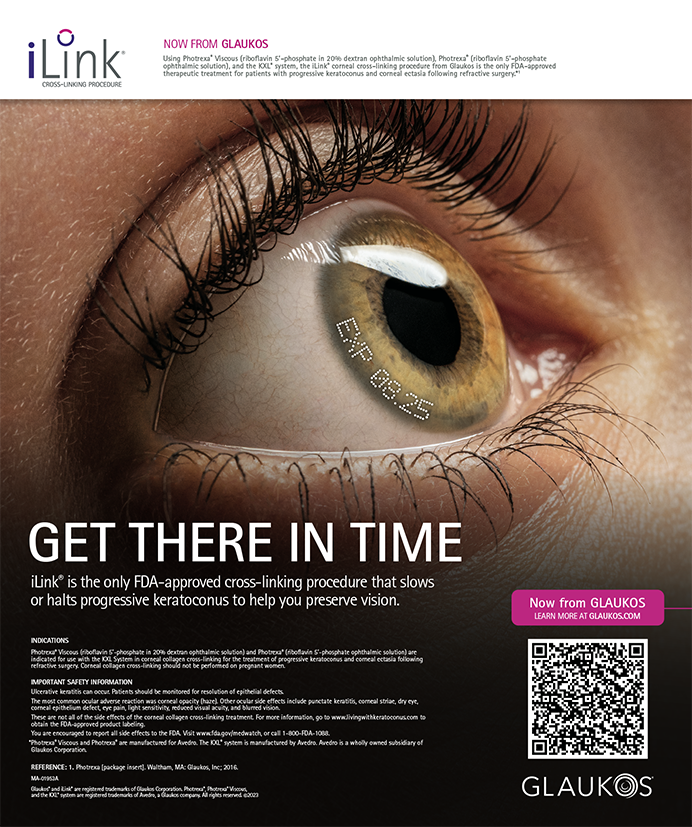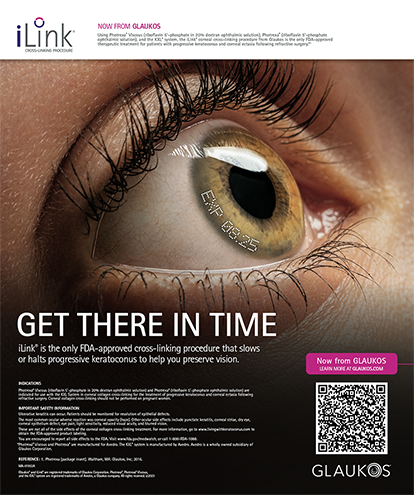CASE PRESENTATION
A 60-year-old symptomatic patient presents with bilateral cataracts as well as 4.00 D of against-the-rule astigmatism in each eye. What would your strategy be for reducing the astigmatism in the initial eye undergoing surgery?
ROBERT H. OSHER, MD
A European surgeon who has access to high-powered toric lenses would manage this case differently. My approach, however, would be similar to that presented in a recent edition of the Video Journal of Cataract and Refractive Surgery.1 After performing microcoaxial phacoemulsification through a 2.2-mm incision, which is astigmatically neutral, I would implant an AcrySof Toric lens (model T5; Alcon Laboratories, Inc., Fort Worth, TX) into the capsular bag and leave the IOL oriented as close to the steepest meridian as possible. If the placement were precise, this lens would correct 2.00 D of astigmatism in the corneal plane. I would treat the remaining 2.00 D with astigmatic keratotomy (AK).
Since 1983, I have used corneal relaxing incisions to reduce preexisting astigmatism. Although these incisions have a greater effect than limbal relaxing incisions (LRIs), the results are variable and highly dependent upon the incisions' depth and length, the size of the optical zone relative to the corneal diameter, the patient's age, and the type of astigmatism. AK is an acquired art in contrast to toric lenses, which are becoming a more precise science. Inaccuracy in identifying and marking the steepest meridian, however, remains a problem that must be improved. Nevertheless, the combined approach I described offers a satisfactory method for managing the cataract surgery patient with high astigmatism.
ROGER F. STEINERT, MD
Ophthalmologists have three effective modalities for dealing with astigmatism at cataract surgery: LRIs; toric IOLs; and LASIK/surface ablation. The disadvantages of excimer laser-based correction are its cost and the need for a separate procedure. Of the three options, however, it is the only one proven to be highly accurate.
In this case, the age of the patient and his high level of astigmatism make excimer laser refractive surgery the optimal choice based on its accuracy and optical superiority. Its added cost compared with a toric IOL is modest for most practices.
LOUIS "SKIP" D. NICHAMIN, MD
The decision whether to use corneal relaxing incisions or a toric IOL to reduce preexisting astigmatism at the time of cataract surgery is determined by the surgeon's level of comfort and experience with each modality as well as specific characteristics of a given patient. I am fortunate to have learned incisional keratotomy and astigmatic theory from pioneers such as Spencer Thornton, MD. I began correcting astigmatism at the time of cataract surgery in the late 1980s, as first described by Dr. Osher2,3 and later by William Maloney, MD.4 In the early 1990s, I became familiar with LRIs through my good friend David Dillman, MD, who first observed Stephen Hollis, MD, as he performed this important variation of AK. I have gradually modified Dr. Hollis' nomogram5 and have achieved superb results with stable outcomes during the past 10 years.6
Using the current NAPA (Nichamin age- and pachymetry-adjusted) nomogram along with pachymetry-guided adjustable depth settings of the diamond blade, I can typically correct up to 2.00 to 3.00 D of astigmatism based upon the patient's age.7
In the presented case, the first factor in my decision would be the patient's desire for a premium multifocal or accommodating IOL versus a standard monofocal implant. If he chose a presbyopia-correcting lens, I would perform LRIs at the time of cataract/IOL surgery followed by a planned bioptics laser enhancement for the expected residual cylinder (again, LRIs are only capable of correcting up to 3.00 D of cylinder) and any remaining spherical error. If the patient were not interested in a presbyopia-correcting IOL, I would either combine LRIs with a toric lens or perform LRIs at the time of the implant surgery with the expectation of a planned bioptics enhancement. Because the toric lenses currently available in the US only correct up to 3.00 D of astigmatism at the corneal plane, some type of combined procedure would be necessary for this particular patient. I still strongly prefer LRIs to "conventional" corneal AK based on the former's more forgiving nature, at least in my experience.
KEVIN L. WALTZ, OD, MD
The STAAR Toric IOL (STAAR Surgical Company, Monrovia, CA) combined with opposing full-thickness corneal incisions on the steep corneal axis would be the most effective and efficient way to treat 4.00 D of preexisting corneal astigmatism at the time of cataract surgery. The STAAR Toric IOL is available with 2.00 or 3.50 D of astigmatic power. The higher-powered lens with a single, on-axis incision would effectively treat the 4.00 D of corneal cylinder. Alternatively, two opposing full-thickness incisions on the steep axis of the cornea would treat approximately 2.00 D of the corneal cylinder, and the remainder could be treated with the lower-powered STAAR Toric IOL. Treating more of the corneal astigmatism would eliminate it, not just compensate for it. Varying the incision's width and distance from the visual axis would allow the surgeon to fine-tune the refractive effect. Ideally, he would use one of the incisions for the cataract's extraction and the lens' insertion, but it is not mandatory.
Section Editors Robert J. Cionni, MD, and Michael E. Snyder, MD, are cataract specialists at the Cincinnati Eye Institute in Ohio. Section Editor Robert H. Osher, MD, is Medical Director Emeritus at the Cincinnati Eye Institute and Professor at the University of Cincinnati College of Medicine in Ohio. He is a consultant to Alcon Laboratories, Inc. Dr. Osher may be reached at (513) 984-5133; rhosher@cincinnatieye.com.
Louis "Skip" D. Nichamin, MD, is Medical Director of the Laurel Eye Clinic in Brookville, Pennsylvania. He acknowledged no financial interest in the products or companies mentioned herein. Dr. Nichamin may be reached at (814) 849-8344; ldnichamin@aol.com.
Roger F. Steinert, MD, is Vice Chair of Clinical Ophthalmology for the Department of Ophthalmology at the University of California, Irvine. He acknowledged no financial interest in the products or companies mentioned herein. Dr. Steinert may be reached at (949) 824-4122; roger@drsteinert.com.
Kevin L. Waltz, OD, MD, is a founding partner at Eye Surgeons of Indiana in Indianapolis. He is a paid consultant to Advanced Medical Optics, Inc. Dr. Waltz may be reached at (317) 845-9488; klwaltz@aol.com.


